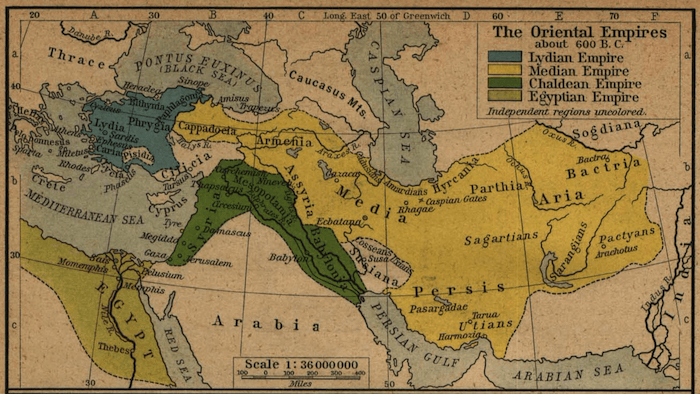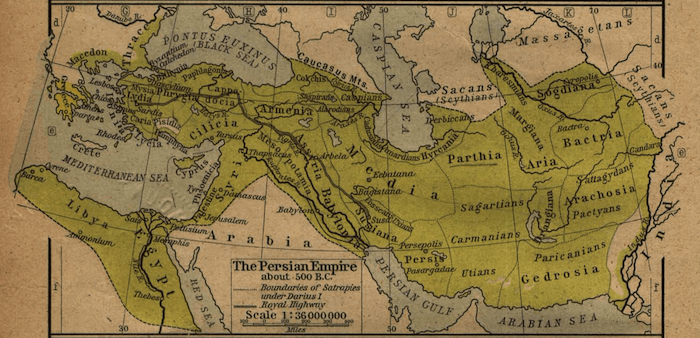Cultures > Chaldea
Chaldea
Background
Around 1000 BC the civilization of Babylonia experienced a period of anarchy and instability which allowed nomadic tribes to settle down near its borders. One of these nomadic groups of people that settled down became the civilization of Chaldea.

Chaldea Map - Chaldea (1874)
The civilization of Chaldea would later become assimilated by Babylonia around 600 BC when a Chaldean leader named Nabopolassar took control over Babylonia and both him and his son Nebuchadnezzar II oversaw the destruction of the Assyrian Empire.
Origins
The original Semitic people of Chaldea settled down in the marshes in the southeastern corner of Mesopotamia on the right bank of the Euphrates River during the period of chaos in Babylonia between 1026 BC and 911 BC. They had arrived there from the Levant and took advantage of the power vacuum that occurred in the region to establish their own kingdom.
They lived in the extremely infertile lands that connected the major river systems to the Persian Gulf. Ever since the times of Sumer this soil has been plagued by a high level salinity which makes growing crops difficult. The northern area of the fertile crescent does not have this problem and therefore a wealth inequality gap was always present. Not only did this breed social discontent between the various populations of Mesopotamia but it was also a primary cause of the wars of conquest and empire in order to obtain access to the scarce natural resources required to build civilization in the desert.
The Chaldeans at some point were conquered by the Assyrian Empire along with the rest of Babylonia.
Nabopolassar
Neo-Babylonian Empire
Under Nabopolassar, Chaldea was able to take control of Babylonia and actually renamed it all Chaldea. This name did not stick as the Chaldean Dynasty of Babylonia was short lived yet it allowed the Chaldeans to assimilate into Babylonia culture. With the Assyrian Empire experiencing a period of instability, Nabopolassar took advantage of the situation and formed an alliance with Cyaxares of Media along with many different groups of people including in order to overthrow the last remnants of the Assyrian Empire.
The anti-Assyrian coalition known as the Revolt of Babylon succeeded and in 612 BC following the Battle of Nineveh. The Babylonians, Chaldeans and Medians sacked and razed the cities of Nineveh, Ashur and crushed the last vestiges of the Neo-Assyrian Empire in battle in 608 BC.
Nebuchadnezzar II
With the collapse of the Assyrian Empire a new, Neo-Babylonia was created and Nabopolassar's son Nebuchadnezzar II oversaw a golden age in Babylon. During this period many of the great wonders were constructed in Babylon that would later astonish the Greeks and other travelers from around the world.

Mesopotamian Empires (600 BC) - Historical Atlas (1923)
Nebuchadnezzar II would also launch successful campaigns that would place the former territories of the Assyrian Empire including Aram, Phoenicia, Kingdom of Israel, Kingdom of Judah, and Philistia. and others in Asia minor and Arabia.
Decline of Neo-Babylonia
Amel-Marduk
Nebuchadnezzar would share power with his son Amel-Marduk (562-560 BC) in his final year before dying in 562 BC. Amel-Marduk would remain in power for two years before he was deposed in 560 BC. He was succeeded by a man named Nerglissar who may or may not have been Chaldean. If he was not Chaldean and in fact a Babylonian noble then this is where the Chaldean influence over Babylonia ends.
While it was short lived, the Chaldean influence over Babylonia is immense in terms of culture and influence. It was these period of brief lived glory after the collapse of the Assyrian Empire that led Babylon to be remembered for hundreds of years into the future.
Nerglissar
Nerglissar (560-556 BC) is known to have waged war against Greek settlers who began moving into the territories of the collapsed Hittite civilization. He only reigned for four years before being replaced by Labashi-Marduk (556 BC) in 556 BC. It is not clear weather he is a Chaldean or not as well.
Labashi-Marduk was in power only a few months before he was replaced by an Assyrian known as Nabonidus. In fact it is ironic that he was from Harran the last Assyrian territory that the previous Chaldean dynasty had conquered in 608 BC. Nabonidus was the final native king of Mesopotamia when the territory was conquered by the Achaemenid Empire under Cyrus the Great.
Achaemenid Empire
When the Babylonia civilization was absorbed into the Persian Empire the term Chaldea lost its meaning in reference to a particular state or people. This process is known as Akkadianization and occurs when a civilization loses its independent identity and becomes part of the larger Assyrian-Babylonian mixed cultural identity. This meant they would have adopted the culture, religion, customs, language and beliefs of the larger civilization.

Achaemenid Empire (500 BC) - Historical Atlas (1923)
This process also occurred with the Amorites, Kassites, Suteans and the Arameans. At this point in history the original people of Chaldea had virtually become assimilated by Babylonia and their histories inseparable. The word Chaldean would become a term that was applied to a specific group of astrologists and astronomers however, which is very interesting to note.
http://www.gutenberg.org/files/24654/24654-h/24654-h.htm